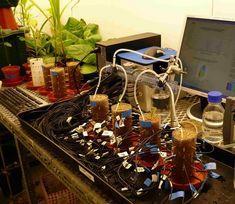
A new tool developed by scientists at the University of Manchester will allow farmers to see under the soil to check how efficiently crop roots are using water and nutrients.
The research could have a strong impact on food security - the subject of this week's announcement by the government that it is consulting on how it can ensure that the UK’s food supply remains safe for future generations.
Dr Bruce Grieve from the Syngenta Sensors University Innovation Centre said: “Climate change means that the ability to rapidly identify new plant varieties tolerant to drought and other stresses is going to be critical to breeding the food crops of tomorrow. Our technology will help do that.”
Chief government scientist Professor John Beddington recently visited the University of Manchester to talk to scientists in the School of Electrical and Electronic Engineering about their project.
Grieve said: “This project will deliver a new visualisation tool for farmers, which will provide them with a 24/7 signal from each and every plant in a screening programme, indicating how efficiently the roots are drawing upon the water and nutrients in the soil.
“These sub-soil sensor systems are novel but founded upon established low-cost body scanner technologies, which exploit the bending of electrical fields within the subject.
“This new tool will not simply provide a picture of the size and shape of the root structure but rather a non-destructive, quantified and real-time indication of how well they function.”
Grieve added: “Currently, above-soil features, or phenotypes, are monitored in industrial greenhouses and field trials during seed breeding programmes to provide an indication of which plants have the most likely preferential genetics to thrive in the future global environments.
“These indicators of ‘plant vigour’ are often based on loosely related features which may be straightforward to examine, such as an additional ear of corn on a maize plant, but are labour intensive and lacking in direct linkage to the required crop features.”
Within the next six months, the team will implement and characterise a next generation of electrical imaging instrumentation which has been designed to meet the specific needs of sub-soil imaging for plant root function.
The tests will be carried out under highly controlled conditions using a single genetic strain of plants and the subsequent findings will then be integrated into a larger research programme alongside micro x-ray tomography.



